St John
the
Evangelist-in-the-East Golding Street 1869
- 1943
(formerly [Low] / [Upper / Middle / Lower] Grove Street)
Further description of the parish area can be found here (a detailed report of 1848) and here (tracing various aspects of its history - industry, housing, criminal associations); parish registers are here.
THE CHURCH
When
the Revd Joseph Marychurch Vaughan
came as curate
of the
parish of St George-in-the-East, his main task was to establish a church in the very
poor area in the northern part of the parish, with a population of
about 6,000. (The Statistical Society's 1848 survey had excepted Upper and Middle [where the church was built] Grove Street as being almost wholly occupied by persons in a condition of life somewhat above that of the poor labourers who surround them, but this was probably no longer true.) Three houses in Grove Street were acquired from Mrs M.A. Harris, the leaseholder, in 1867, for a parsonage. (The mortgage was held by C.C. Druce, and the renowned locally-born secularist Charles Bradlaugh was trustee of Mrs Harris.) The church, with 500
sittings, was built on the cheap, at a cost of £3,500. The
Bishop of London's Fund gave £1,500, the London Diocesan
Church
Building Society £300, the Incorporated Church Building
Society
£150 and Marshall's Charity £100; he had to find
the
rest. He was a freemason (a member of Royal Albert Lodge, and later of
Asaph Lodge), and appealed for help in the Freemasons
Magazine & Masonic Mirror
of 1868:
|
The
new district of St. John, in the parish of St George-in-the-East, is
situated on the borders of the London Docks, and has a poor
population of 6,000 souls. Moved by a conviction of the very urgent
spiritual need of the district, the working men (the bulk of whom are
dock labourers, costermongers, and seafaring men) have formed
themselves into a committee, and are going literally 'from house to
house,' to obtain contributions to the Church Building Fund. It may
be interesting to state further, that the children in the free
schools have also united to help on the work, and that there are at
the present time no less than 166 contributing 1/2d. a-week, while
there are other labourers in the district who are obtaining
contributions that vary from 1d. to 6d. a-week. For three years the
missionary clergyman has carried on his work in a school-room and
from house to house; he has a Scripture-reader, a mission-woman,
and a district nurse labouring with him — a free school (of which the
Right Hon. the Earl of Shaftesbury is President), with 307 children
on the books, and an average attendance of 117 — a lending library,
containing about 400 volumes of an interesting and instructive
character — a penny bank, in which last year was deposited £54 9s.
by 179 depositors — a soup kitchen for giving occasional dinners to
the more sickly and destitute children, and for supplying the poor of
the district with nutritious food during the winter months — a
mother's meeting, average attendance 30 — a sewing class three times
a week for teaching the children to make articles of clothing for
themselves — and penny readings, with the view of giving the working
classes a pleasant and profitable evening, and to encourage in them a
taste for intellectual pursuits. But while the above has been done,
and these agencies for good are all in active operation, the
committee feel that very much remains yet to be accomplished before
the parochial system is thoroughly established among them. They are
convinced that a church should be built; and that, when this is
completed, they will then have secured for the 'labour of love'
going on in their midst, that permanency which they so ardently
desire.....
The
Building and Working
Men's Committees venture to make an earnest appeal to all who value
the blessed privilege of a House consecrated to the service of prayer
and praise, to assist them in the proposed work by contributing at
least a shilling in postage stamps. Should, however, any be disposed
to make a larger donation, cheques crossed "East London Bank"
or Post-office Orders made payable at "Eastern District
Post-office,'' Commercial-road, E. may be sent to the Incumbent
designate, the Rev. J. M. Vaughan, 33, Nassau-place, Commercial-road,
E. or will be thankfully acknowledged by any of the following
gentlemen :— Rev. J. Cohen, M. A., Rесtor of St. Mary's,
Whitechapel ; Mr. Henry Mosely, 9. St. George's-place, St.
George-in-the-East; Rev. J. G. Pilkington, M.A., Clerical Secretary,
Bishop of London's Fund, 46A Pall Mall; Rev. T. J. Rowsell. M.A.,
Chaplain to the Queen, Rector of St. Margaret's Lothbury; Rev. F. W.
Russell, M.A., 35, St. Augustine-road, Camden-square, N.W.
Contributors of 5s. and upwards
will be presented with photograph of the new church.
|
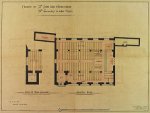
 The
architects were the Francis brothers Frederick John (1818-96) and
Horace (1821-94), whose practice was at 38 Upper Bedford Place,
Bloomsbury; Messrs Dove were the builders. The foundation
stone
was laid by the
Bishop of London on 29 April 1868, and he consecrated the church on
12 February 1869, with the Archbishop of Canterbury present [drawing left from the Illustrated London News, 20 February 1869; ICBS plan 06719 of new church, with gallery, right]. Mr
Vaughan was inducted as the first vicar.
The
architects were the Francis brothers Frederick John (1818-96) and
Horace (1821-94), whose practice was at 38 Upper Bedford Place,
Bloomsbury; Messrs Dove were the builders. The foundation
stone
was laid by the
Bishop of London on 29 April 1868, and he consecrated the church on
12 February 1869, with the Archbishop of Canterbury present [drawing left from the Illustrated London News, 20 February 1869; ICBS plan 06719 of new church, with gallery, right]. Mr
Vaughan was inducted as the first vicar.
St John's was built of stock brick, with stone dressings, and consisted
of a nave and aisles of five bays, the last bay of which formed the
chancel. The construction of the east window suggested that a chancel
extension was envisaged, but this never happened. At the south-west
was the base of a tower which should have been completed with a
belfry stage and a brick spire; this too was never finished, and a
single bell was hung in a wooden frame on the top of the tower.
The organ -
2 manuals, 15 speaking stops - was built by Gray and Davison in 1869,
at a cost of £318. Vaughan stressed (no doubt with events at St George-in-the-East in mind) that he wanted to have a thoroughly good musical service,
at the same time most carefully avoiding all extremes. See this report from the Musical Standard of 20 February 1869.
THE DISTRICT
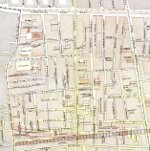
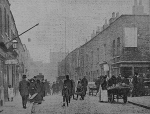
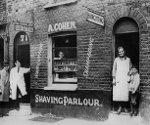

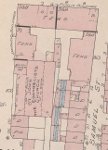 The 1878 Vestry map [left]
shows the area served by the church: at that time, a mix of very poor
dwellings and industrial sites, many of whose owners are identified on the map. Left is
also Grove Street (looking north) in the late 19th century, and Goad's
insurance map of 1899 showing the block around the church, which was
surrounded by tenements to the north (Bewley and Ficklin Buildings) and
small houses with workshops behind to the east and south, with a pub
next door but one (the Jolly Sailor, 85 Grove Street - which had a
German landlady in the 1890s). Only the south side of the church was
visible. It became
an increasingly Jewish area, as settlers moved east from Whitechapel - right is a 1913 tailors' workshop in Christian Street, and a shop in Ellen Street in the 1930s. More pictures here.
The 1878 Vestry map [left]
shows the area served by the church: at that time, a mix of very poor
dwellings and industrial sites, many of whose owners are identified on the map. Left is
also Grove Street (looking north) in the late 19th century, and Goad's
insurance map of 1899 showing the block around the church, which was
surrounded by tenements to the north (Bewley and Ficklin Buildings) and
small houses with workshops behind to the east and south, with a pub
next door but one (the Jolly Sailor, 85 Grove Street - which had a
German landlady in the 1890s). Only the south side of the church was
visible. It became
an increasingly Jewish area, as settlers moved east from Whitechapel - right is a 1913 tailors' workshop in Christian Street, and a shop in Ellen Street in the 1930s. More pictures here.
St John's never had its own church school. The first Board School built in the parish was in Berner Street [now Henriques Street] in 1871. Opposite, on what is now the playground of Harry Gosling School,
was discovered in 1888 the body of one of Jack the Ripper's victims -
see here for more details. In 1901 another Board School was built near
the church in Christian Street.
(This site previously housed London's tallest chimney, of Martineau's
sugar refinery, which burnt down twice in the 19th century - see here for an account of this trade, including several patents registered by Gerd Bensen of Christian Street, and here
for the subsequent history of the school. Opposite was a synagogue, now a mosque.)
THE
CLERGY
Joseph Marychurch Vaughan
was curate of the parish church (Crockford says 1865, but he had
conducted weddings here throughout the previous year, signing as
'curate' from April), and first incumbent of St John's from 1869-79. He was
one of nine children of a parson, Dr John Vaughan
(no relation to D.J. Vaughan's family at St Mark Whitechapel) and
Elizabeth Marychurch. Dr Vaughan had served in Great Yarmouth,
Yorkshire and Wiltshire before becoming perpetual curate of Brixton
(based at the recently-built St Matthew's church) from 1841-56, when he
retired to Regent's Park - being a man of independent means. (In his
last year at Brixton he was party to a curious fraud case
concerning burial fees.) His son Joseph studied at Trinity Hall Cambridge and
King's College London (part of the first generation who undertook
specific ordination training there) and was ordained in
1859 (by letters dimissory from the Bishop of Rochester) serving his
title in Shildon, county Durham and from 1860 a curacy at St James
Hove. Here he assisted his brother Matthew (who had been their father's
curate in Brixton, and then incumbent of St John Brixton) in the marriage of
their widowed sister Decima [= child no.10!] Another brother Mark
was also ordained, as were other family members, and the women married clergy.
|
Two
of the weddings he conducted at St George-in-the East were of Alaxander
Ronald to Jane Anderson, on 18 September 1864 (for which his
great-grand-niece Ann Gillespie has provided details); and ten days
later, oOn
28 September, the marriage (also by licence) of a former neighbour from Edmonton Robert Vaux Zinzan
to his stepmother Mary Ann
Green, although they had no connection with the parish (despite giving
their residence as 107 Cannon Street Road) and providing false
information, declaring her to be a spinster. Zinzan's father (Robert
Comport Zinzan), like his son, was a surgeon and apothecary, and had
four children by his first wife, in London; she died, and the family
moved to the Wiltshire village of Hindon where he married the daughter
of the local publican (he was 41, she was 18); this marriage was
childless. He died of 'exhaustion' in 1862, and two years later Mary
became pregnant by her stepson, who sought to regularise their
relationship. The marriage was challenged, on the
basis of evidence provided by the parish clerk of Hindon - based on the
Book of Common Prayer's Table of Kindred and Affinity,
which provides that a man may not marry his father's wife [=
stepmother, since the mother must have died for this to become a
possibility] despite there being no blood link; it resulted
in a case at the Aldermans' Court, Guildhall, with a warrant for his
apprehension, though this was not executed (a report appeared in The Times of 12 December 1864). The marriage was
presumably annulled, since in 1866 Zinzan married Isabella Griffith at East
Knoyle parish church, and they moved to Onehunga, a suburb of Auckland
in New Zealand, where in 1870 he applied for his medical qualifications to be
recognised, dying nine years later of cirrhosis of the liver. In due
course the family produced noted Kiwi rugby and cricket players.
Louisa, the child of the forbidden relationship, became a Sister of
Mercy at the (Anglican) house of St Denys Warminster, where she died in 1920. See more here.
|
To add to the challenge of establishing a new church in a poor district, and to provide part of his stipend, Vaughan was also appointed chaplain of the workhouse from 1870. He
left St John's after 14 years for a lighter sphere of
work,
much needed after the long overstrain of mind and body amid a population of more than 10,000 (Coral Missionary Magazine 1880),
to become vicar of St Thomas of Canterbury, Dodbrooke, in Devon. But he
only
stayed there a year, and for a further year as vicar of Englishcombe,
near Bath, before returning to London in 1882 as vicar of St Nicholas
Deptford, in Rochester diocese. Sadly, in 1886 he fell into
trouble over drinking and debts and was declared bankrupt - Lambeth
Palace Library holds letters of 1897 on the subject. He went
to Queensland (sailing out on the steamer Austral - the newspapers reported that there were 685 in the other classes for all ports),
and worked in Townsville. In 1890 he was part of a Musical and Dramatic
Society Committee in Cootamundra, whose member intended practising regularly with the view of giving some concerts in aid of the charitable situations.
Vaughan's successor (1879-1909) was George Thomas Cull Bennett
(see Charles
Booth archive
B222 pp20-35). He was a St Bees' trainee, and was ordained by the
Bishop of Carlisle by letters dimissory, to serve in Durham diocese, in
1863 (in the same service as North Green-Armytage),
to the curacy of St James Benwell, Newcastle (then in the diocese of
Durham); from 1868-76 he was curate of Cockfield, in country Durham,
and then for three years incumbent of Kenley, near Shrewsbury (where he
and his wife Maria - who died during his time there - was
involved in legal proceedings over the mortgage on Bishopscourt
Farm, Shapwick near Blandford). He was musical, and one of
many Victorians
who
wrote music for Miss Margaret Ann Headlam's harvest hymn Holy
is the seed-time; in 1880 he published an anthem It came even to pass. He
was a supporter of the Family Welfare Association, the Charity Organisation Society
(serving on its local committee) and the East London Nursing Society,
and a regular
attender at meetings of the Society for the Propagation of the Gospel.
In 1882 he was the Friday (St Antholin's) Lecturer at St Mary Aldermary
in the City [a post funded by a long-established charity, whose holders
latterly required the Bishop of London's approval].
The 1886 Religious Survey of London records attendances on 24 October of 98 in the morning, and
128 in the evening; see here for statistics of baptisms and weddings during the lifetime of the church.
Charles Booth, writing in 1902, commented that the parish, by then 70% Jewish, had a small, but attached
congregation, with an inner circle of communicants devoted to the
vicar, and most of them have formerly been parishioners though they may
be so no longer. The most interesting piece of work is a Bible-class
held by the vicar. It is crowded, and such is the pressure that if
absent three times a member forfeits his place, and in a recent year out of
fifty-five members forty-eight did not miss a single meeting. The fact
is remarkable, and the explanation no less so. The Bible is made the
vehicle for lessons in science, and the resources of the laboratory are
freely used to illustrate its words. '"God made the firmament" — what
do they know about the firmament?' So their vicar gives the class an
insight into the nature of gases. And so absorbing is the interest of
the course, and so thorough the teaching, that It has taken six years
to reach the end of Genesis.
He remained here for thirty years, as a widower; in January 1902 at the
age of 64 he married Louisa Nelhams (aged 42) at
St John's, with his
long-serving curate Charles Reeder officiating. She was a
well-qualified nurse who had worked at the Victoria Hospital Chelsea,
in Edinburgh and Glasgow, at Guy's and Westminster Hospitals.
When he retired they moved to Blything in Suffolk, where he died in
1911, aged 74. Louisa then moved to Guildford and died in 1916, aged
57, at Netherne Mental Asylum, Hooley, near Coulsdson.
Curates up to the First World War
In 1865, in some
desparation,
Vaughan had advertised in The
Ecclesiastical Gazette for a curate, at a stipend of
£130 a
year - views moderate, schoolroom
services - to help him build up the new district.
- Thomas Charles Hills was the first to respond, though did not stay long. (This needs confirming: the 1866
Clergy List has 'C. Hills' as curate of St John's, St George's-in-the-East,
but it is not recorded elsewhere.) He trained at St Bees and served a
2-year curacy in Derby (then in Lichfield diocese) until 1864, when he
became northern and Scottish secretary for the Patagonian Mission (later the South
American Missionary Society).
He returned to Lichfield diocese in 1867 as Vicar of St Mary Bolsover, a
poorly-endowed but historic church (dating from 1020, restored in 1877) in the patronage of the Duke of
Portland, with a stipend of £120, including 56 acres of glebe; there he became the first chairman of Bolsover Urban District
Council
- 'Hillstown' was named after him. He was the custodian of a
sugar bowl which was a rare example of 'Bolsover ware' (the kilns had been
destroyed in 1750).
In the next few
years, Vaughan received occasional help from curates of other local
parishes, including Coleman Connolly of Christ Church Watney Street,
and Henry Hugh Beams Paull of St Paul Shadwell (whose wife Susannah was
a translator of children's books, including Andersen's and Grimm's
fairy tales).
- Stanley Hamilton Hayes
(1873-74) trained at Trinity College Dublin, and was ordained in 1865
to the parish of Aughnaneidlen in the diocese of Down, Connor &
Dromore, moving the following year to Edensor (the Chatsworth estate church in Derbyshire) and in
1868 to Bordesley, Birmingham (then in Worcester diocese), living at Grosvenor Terrace, Cattell Road, where he was
discharged from bankruptcy the following year (a fate that befell a singificant number of
curates who served in our parishes, and in due course his vicar here - see above);
after further brief curacies at St Stephen's Redditch, St Peter's St
Alban's and Chatham (where he made composition with his creditors) he
came here. He married Rebecca Farmar. By 1886 he was chaplain at the Westminster Workhouse in
Poland Street - in the religious census
of that year, morning attendance at the chapel was 160 and evening 180;
he remained in post into the First World War. In 1913 the Westminster,
Strand and St George's [Hanover Square] unions merged as the City of
Wesminster Union and the Poland Street premises were closed; the
following year the building was taken over by the Metropolitan Asylums Board
for housing wartime refugees: on 5 September 200 Russian Jews, mostly
from Antwerp, were placed there. A week later, the premises were handed
over to the Jewish authorities and continued in operation as the Poland
Street Institute for Jews. The buildings were reconstructed as a garage
in 1925, and the site is now a multi-storey car park.
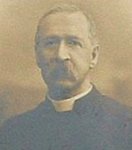 David Nickerson (1875-76)
was Canadian, studied at King's College Windsor in Nova Scotia and was
ordained in 1868, serving in three parishes in Nova Scotia
and New Brunswick, the last including a chaplaincy to the British Army.
After his short time here, and a year as chaplain to the Islington
Union, he became a Chaplain to
the Forces, with postings in this country and abroad (including Cyprus,
Egypt and Malta) for the next two decades. While in Portmouth in 1887
he published a threepenny broadsheet under the odd pseudonymn 'Don't
Care' Is Free Trade a Mistake? [echoing an earlier title of John Bright, and an ongoing debate], Dedicated to the Production of England, both Capital & Labour. He said at a
conference that the best prospect for a Poor Law child was to draft him
into the army or navy. He became
curate of Netley in 1900, Rector of North Stoke (near Bath) in 1902 and
Vicar of Harlington, near Dunstable, in 1905. Before he left the
Army, he produced The Origin of Thought (Kegan,
Paul
& Trench 1901), an introduction to philosophy 'for thoughtful
people of good education but who have not read philosophy', in a light and popular manner, said one
review, but with a misleadingly
abstruse title. Another review, Black and White, said while
on some points the book is philosophically unsound, it is written in
such a bright, attractive way that no one can read it without being
charmed by the personality of the writer. He described in detail a baby's growth to consiciousness, and speculated on the links between thought and electricity. In
1909 he became vicar of Newton-upon-Ouse in Yorkshire (Elsie Folkes,
his servant in Harlington, successfully suing him on his departure for
£2 in lieu of notice). His son Major General William
Henry Snyder Nickerson was a Canadian recipient of the Victoria
Cross for his service, as a lieutenant in the Royal Arrmy Medical
Corps, to a wounded man at Wakkerstroom in the Boer War.
David Nickerson (1875-76)
was Canadian, studied at King's College Windsor in Nova Scotia and was
ordained in 1868, serving in three parishes in Nova Scotia
and New Brunswick, the last including a chaplaincy to the British Army.
After his short time here, and a year as chaplain to the Islington
Union, he became a Chaplain to
the Forces, with postings in this country and abroad (including Cyprus,
Egypt and Malta) for the next two decades. While in Portmouth in 1887
he published a threepenny broadsheet under the odd pseudonymn 'Don't
Care' Is Free Trade a Mistake? [echoing an earlier title of John Bright, and an ongoing debate], Dedicated to the Production of England, both Capital & Labour. He said at a
conference that the best prospect for a Poor Law child was to draft him
into the army or navy. He became
curate of Netley in 1900, Rector of North Stoke (near Bath) in 1902 and
Vicar of Harlington, near Dunstable, in 1905. Before he left the
Army, he produced The Origin of Thought (Kegan,
Paul
& Trench 1901), an introduction to philosophy 'for thoughtful
people of good education but who have not read philosophy', in a light and popular manner, said one
review, but with a misleadingly
abstruse title. Another review, Black and White, said while
on some points the book is philosophically unsound, it is written in
such a bright, attractive way that no one can read it without being
charmed by the personality of the writer. He described in detail a baby's growth to consiciousness, and speculated on the links between thought and electricity. In
1909 he became vicar of Newton-upon-Ouse in Yorkshire (Elsie Folkes,
his servant in Harlington, successfully suing him on his departure for
£2 in lieu of notice). His son Major General William
Henry Snyder Nickerson was a Canadian recipient of the Victoria
Cross for his service, as a lieutenant in the Royal Arrmy Medical
Corps, to a wounded man at Wakkerstroom in the Boer War.
Curates in Cull Bennett's time were:
- Edwin
Theodore Lewis (1880-86) was
ordained
deacon in South Africa by the Bishop of Grahamstown in 1874, where he
served a three year curacy at Holy Trinity, King Williamstown; he came
to England and was briefly at Holy Trinity, Gray's Inn Road and St
Michael Bromley-by-Bow before coming here, and was not
priested until 1881. Although he stayed here six years, most of his
later curacies were brief: Grays Thurrock and Hanningfield (both in
Essex), St James-the-Less Bethnal Green (remaining for six years) and
St Peter Stepney. Leaving London, he held posts in Asterby,
Lincolnshire; Freshwater and Sandown (both on the Isle of Wight); and -
going to the opposite end of the land - St Andrew, Fort William. He
retired to Bristol in 1904, appaently holding no further posts.
- Henry
John Frye (1883-87),
born in Thaxted in 1851 (where his father Philemon was a bookseller),
trained at Lichfield (a theological college founded in 1857), and
ordained in that diocese in 1882, serving in Smethwick; from here, he
went on to curacies in Chesterton (Staffordshire), Little Ilford, and
Northmoor Green, Holton and West Pennard (all in Somerset), and in 1902
became the chaplain of Shepton
Mallet prison
(built in 1625 and still in use, though it has been through many
changes; in Frye's time the number of inmates was relatively low). He
died at Shepton Mallet in
1913.
- Samuel Secretan (1884)
is described as an 'Irishman and perpetual curate'! It is true that he
had studied at Trinity College Dublin (winning the Hebrew Prize in
1854) - though he had also attended St John's College Cambridge - and
also that he served at least eight brief curacies and never held a
benefice up to his death in 1911. He was from a French
Huguenot
family, some of whom achieved distinction (including Charles Secrétan,
1815-95, a Swiss philosopher of religion). Frederick Samuel
Secretan (1750-1837 - his grandfather?), was naturalised, became a
member of Lloyd's, had 15 children, and retired to Monmouthshire.
Samuel had academic pretensions: in 1866 (apparently living in
Leicester) he published Remarks on 'Ecce Homo' (one of many critiques of an essay of that year by Sir John Robert Seeley - W.E. Gladstone penned another). For a time he
tried his hand as a schoolmaster, at Howden in Yorkshire; here
is a
caustic critique of a sermon, in curious style and reflecting his
fascination with liberal scholarship, which he preached there and
published. His name does not appear as an officiant in the
baptism or marriage registers at St John's.
- Charles Clare Dawson Smith (1887-88)
[later hyphenated as Dawson-Smith], was one of our few clergy to train, as a non-graduate,
at Chichester (which J. L. Ross had
helped to found fifty years earlier before he became Rector of St
George-in-the-East). He was ordained in 1885 to a curacy in New
Brampton (Chesterfield - then in Southwell diocese), and after his
short time here and a further curacy in Burnham became in 1897 Rector
of Thornton-cum-Nash, near Stony Stratford (in Oxford diocese - with Beachampton
from 1922) until his death in 1935. (He re-appeared briefly at St
John's in 1910 to help
out.) In 1905 he put in a patent application [25939] for improvements in explosives for shot and other guns.
In 1917 Thornton Hall, and all the land surrounding but excluding St
Michael's Church and Rectory, was leased by its owner, Colonel Henry
William Harris, 'gentleman', to the Roman Catholic Sisters of Mary and
Jesus as a girls' school, Thornton College;
this fascinating document (which includes detailed provisions for
wartime hostilities, as well as for garden produce and chandeliers in the
house) can be read here. His son Lt Frank
Dawson-Smith, who had been a regular contributor to Bird Notes, was
murdered by mutineering
Somali soldiers of the King's African Rifles at Ramo in Jubaland on the
Abyssinian border in 1920. He was a 'communicator' in psychic sittings
attended by his mother.
- Daniel Radford (1887-92),
ordained in 1871, 23 years after graduating from London University;
he came here after six curacies (Emmanuel Camberwell, St Peter Streatham, St Augustine Hackney, St Nicholas Chiswick, St Mary Harlow
and St Barnabas Kentish Town). At Chiswick in 1881 he published Studies at the Foot of the Cross: Seven Good Friday Addresses, and at Harlow in 1883 he entered into debate on 'polychurchism',
a term coined by high churchmen to denigrate the view of those who
claimed that the early church was made up of many separate
congregations, and that unity today therefore does not require visible
unity and central leadership. His main point, as he explained in the Church Times, was: The
reply to the Roman Catholic argument that the Church, being a visible
body, must possess a visible head, is simply this, that Christ is a
visible head, for what we mean by an object being visible is not that
it is in a position to be seen by this or that number of eyes at a
given time, but that it is in itself capable of being seen; that, in
short, it is not a mere impalpable spirit. He characterised the Roman church as a bi-capited monster, for which his critics accused him of perfervid imagination. But he was catholic rather than evangelical, influenced by the English Church Union, of which he was a member, and publishing a
courteous 'eirenicon' in response to the evangelical Bishop Charles
Perry, formerly of Melbourne, The Theology of Christian Ordinances (Rivingtons
1884) explaining why he had changed his views.
He left here to become the last resident
rector
of
Papworth St Agnes near
Cambridge, remaining until 1916. This was a congregation
started in the 1830s by
the missionary
preaching in a barn of H.J. Sperling (whose family remained patrons of
the parish and local landowners). His stipend there was £195, with 79
acres of glebe; the population was 153. When he left, it was joined to
Graveley. His youngest son Francis married in Australia in 1905.
On 25 July 1910 he contributed to
correspondence in The Times about 'long generations':
Sir, I do not know
whether but dare say there are many family instances like my own, but
on this subject it may be of some interest to mention that my
great-grandfather was born in the reign of Charles II. If this savour
of antiquity it is partly explained by my being more than half-through
my 83rd year, the youngest child but one of my father, who had ten
children, and who was himself the youngest but one of 25 children by
the younger of two wives.
Yours faithfully, DANIEL RADFORD
|
- Richard Alexander England (1890)
- born in 1843, from student days at Jesus and Caius Colleges, Cambridge in the
1860s he had money problems, despite a life interest in the Stibbard
estate in Norfolk, which he inherited when his father, Dr William England of Ipswich, died in 1871 and
mortgaged. He was ordained in 1869 to a title in Bicester (Oxford
diocese), priested the following year by the Bishop of Worcester for St George Birmingham, and served
curacies off and on in various places. He wrote occasionally for the Church of England Pulpit and Ecclesiastical Review
(founded in 1873 by A.J. Melhuish with articles on various topics, not
just religious): for example, 'Marriage: a Type of Christ and his
Church' in 1879; he also pulished a sermon on Bishop Selwyn of New
Zealand and Lichfield in the year of Selwyn's death (1878). In 1882 he
became Rector of Wyke Regis, in Weymouth (in Doreset, but the Bishop of
Oxford was patron), with a net stipend of £318, though was
non-resident. In 1883 he advertised in The Guardian Curate wanted immediately, for charge of mission chapel, two Sunday servces, light work, stipend £100.
By 1888 the vicar of nearby Fleet, Thomas Morgan Bell-Salter, was
curate in charge; England had been declared bankrupt in 1886. He later
lived in Penzance, and died in Southend in 1912.
- John
Thomas Hughes
(1890-98), who trained at St Bees and served curacies
in Cumbria and Newcastle before coming to London; from St John's he went to a further curacy in Tottenham.
- Charles
Reeder
(1892-1902), also St Bees: he stayed here for ten years, but his
previous seven curacies, and two later ones, were brief; he became
vicar of Clapton, near Peterborough in 1906 until his retirement in
1929. In 1903 from Kimbolton, near St Neot's, he produced a testimonial
for the Encylopædia Britannica:
question 7 (of 20) asked Is it of
practical use to Clergymen?
- Andrew
Weinstein
(1890-93), a Jewish convert who subsequently worked in South
Africa, Australia and the USA; he baptized a number of Jewish children
and adults during his time at St John's - see more about him here.
- William
John Thorburn
(1902-09) trained at SPCK's Southwark College and served for six years
as a chaplain at Madura in South India
and then for six months at
Gascoyne in Western Australia, at a mission station established by a
descendent of Charles Besley Gribble, the first minister of St Paul Dock Street;
but he became ill and had to return home; after four further curacies,
St John's was his last post and he retired to Oldham and died soon
afterwards.
 Joseph Vaughan, the first incumbent, initially lived at 33 Nassau Place, Commercial
Road East, and later at 12 Commercial Place, but all his successors lived at 400
Commercial Road [left], a
4-storey terrace house at some remove from the parish and in a noisy location. At 384-392 was the SPCK training college (see here) and at 394-396 a maternity hospital
(founded as the Mothers' Lying-in Home in Glamis Road, moving to this
site as the East End Mothers' Home, 1902-03, and becoming the East End Mothers' Lying-in Home
1903-26, taking over the college premises; more details here.
Joseph Vaughan, the first incumbent, initially lived at 33 Nassau Place, Commercial
Road East, and later at 12 Commercial Place, but all his successors lived at 400
Commercial Road [left], a
4-storey terrace house at some remove from the parish and in a noisy location. At 384-392 was the SPCK training college (see here) and at 394-396 a maternity hospital
(founded as the Mothers' Lying-in Home in Glamis Road, moving to this
site as the East End Mothers' Home, 1902-03, and becoming the East End Mothers' Lying-in Home
1903-26, taking over the college premises; more details here.
During the Second World War (the last Vicar having left), it
was used as a hostel for bombed-out pensioners, and from here the
British Federation of Young Co-operators (linked to the Labour Party)
published in 1945 a pamphlet Talking
to Some Purpose, an outline course for a youth discussion group;
Hahn and Co, timber merchants, also had their office here. At this period it was known as 'Church House'. Ethel Upton, who worked with Fr Groser,
lived here for a time after the War, as did the Grosers
themselves a few years later, while work on St Katharine's was being
completed. In 1968 the Church Commissioners
bought it to house the newly-appointed Bishop of Stepney,
Trevor Huddleston CR, who wanted to be among his people. (His
predecessor, Evered Lunt, had lived in the West
End, and then among the Canons of St Paul's in Amen Court). His
successor Jim Thompson also lived here for a time, before deciding that
he should move somewhere smaller; but it proved too small, so he moved
again, to the current bishop's house in Coburn Road E3. 400 Commercial
Road later became a cycle shop, and is now split into flats.
THE TWENTIETH CENTURY
Hastings
Leonard Langley (Vicar
1909-19)
saw St John's through the war years, but died in 1920. Born in
Chichester in 1870, he had trained at King's College
London and was ordained in 1895. After a year's curacy at Coggeshall in
Essex (in St Alban's diocese) he went to work
with its previous vicar (Hubert Mornington Patch) at St Mary
Charterhouse, a slum parish in Finsbury [now part of the parish of St
Giles Cripplegate], from 1897-1909, marrying in his last year there.
When he left, Brian Edward Waud
became priest in charge for a short time. His father, Samuel Wilkes
Waud, Rector of Rettendon in Essex, was 57 when he was born in 1858. An
exhibitioner of the Fishmongers' Company (on £20 a year) as a student
at St
John's College Cambridge, a curate in Leytonstone and Leeds, he was
one of Fr
Dolling's
curates at the time of his death in 1902 at All Saints Poplar, one of
the many clerical colleagues who assisted in his elaborate funeral
rites (with Mass every half hour from 4.30am until his burial at
Brookwood). At Poplar he had started a boys' rowing club on the River
Lea. He was briefly all All Saints' Edinburgh, returning to Limehouse
Rectory and then to the Clergy House of St Mary Cable Street, and was still living in the 1930s.
But the style of the parish was about to
change....
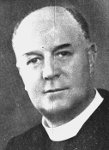
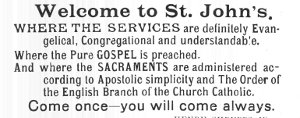 The penultimate
vicar
(1919-39) was Henry
Shrubbs.
Born in Cambridge in 1880, he was a schoolmaster when he married
Maud Allen in Lambeth in 1903; he then studied at Fitzwilliam Hall [not
yet a college] in Cambridge and
trained at Ridley Hall, and was ordained in 1908 to curacies at St
Thomas Stepney (when he lived at 432 Commercial Road, close to St
John's vicarage) and Christ Church Spitalfields. He he
was involved with the Church Army, and to the disapproval of some
conducted
a number of baptisms at
their local headquarters. The parish magazine - buses 15a,
23a and
40a, trams from Aldgate and Bloomsbury [see here for more details] - set out his pitch » » »
The penultimate
vicar
(1919-39) was Henry
Shrubbs.
Born in Cambridge in 1880, he was a schoolmaster when he married
Maud Allen in Lambeth in 1903; he then studied at Fitzwilliam Hall [not
yet a college] in Cambridge and
trained at Ridley Hall, and was ordained in 1908 to curacies at St
Thomas Stepney (when he lived at 432 Commercial Road, close to St
John's vicarage) and Christ Church Spitalfields. He he
was involved with the Church Army, and to the disapproval of some
conducted
a number of baptisms at
their local headquarters. The parish magazine - buses 15a,
23a and
40a, trams from Aldgate and Bloomsbury [see here for more details] - set out his pitch » » »
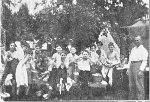
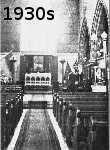
 Despite
a low church stance, he maintained two (sometimes three)
celebrations of the eucharist each Sunday - though it seems from the
details here, from The Parish Record
of 1937 (no.210), that 11am was a 'stay-behind' following Mattins -
plus on saints' days, and a midweek service of Compline. The list of
staff and organisations is interesting: there was a full
programme (and the registers show reasonable numbers), yet when the war came, although the church was not blitzed, it failed quite rapidly. Right is a picture of a 'Bucket Parade in Camp' (?) from 1937, and left the church interior in the 1930s. Several
other items in this edition of the magazine are also of interest, both
for the attitudes they reveal and for the contrast with today, for instance on safeguarding, multiculturalism and bank interest rates!
Despite
a low church stance, he maintained two (sometimes three)
celebrations of the eucharist each Sunday - though it seems from the
details here, from The Parish Record
of 1937 (no.210), that 11am was a 'stay-behind' following Mattins -
plus on saints' days, and a midweek service of Compline. The list of
staff and organisations is interesting: there was a full
programme (and the registers show reasonable numbers), yet when the war came, although the church was not blitzed, it failed quite rapidly. Right is a picture of a 'Bucket Parade in Camp' (?) from 1937, and left the church interior in the 1930s. Several
other items in this edition of the magazine are also of interest, both
for the attitudes they reveal and for the contrast with today, for instance on safeguarding, multiculturalism and bank interest rates!
(1) SUNNY DAYS
An army of girls and boys had enjoyed a fortnight's holiday at
the sea or in the country, and the Vicar expressed gratitude to those
who had made this possible. Of
course, one or two more venturesome boys and girls had to be rescued
from the deep, and a fight resulted in heart-strain for one excitable
youngster. Such things must be .... John Bull, the Verger,
reported that at one camp by the sea over 2,000 poor boys were
gathered, and that he would never forget the sight or the experience.
(2) A ROYAL VISIT
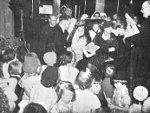 It is some years since St. John's was honoured with a royal visit. In 1922
H.R.H.The Princess Beatrice opened the Winter Sale of Work and this
June H.R.H. The Duchess of Kent accompoanied by The Countess of
Brecknock came to Church, listened and took part in a short programme
of sacred music given by the juvenile Organisations and afterwards
presented some 80 prizes to Sunday School children and Bible-class
members. The visit was with difficulty kept secret until a few hours
before the event and thus was particularly a Christian family
gathering. Entrance to the Church was restricted to the regular
worshippers and the parents of the children. Hundreds gathered in the
street and thus secured a good view of our beautiful Princess and wife
of the King's Brother. Inside the Church the proceedings were carried
through quietly, reverently and without fuss. In the Church porch the
Bishop of Stepney presented the Vicar to Her Royal Highness and he in
turn presented Mrs. and Miss Srubbs, Rev. Dudley Gray and the Wardens
and their wives. Mr. Bull in gown and carrying his staff of office
escorted the company to the Chancel. The Princess expressed her real
pleasure in coming to St. John's (her first visit to the East End),
her earnest appreciation of all that the Church is endeavouring to do.
It fell to Lydia Gardner the most-regular scholar to present a beautiful bunch of flowers to Her Royal Highness. It is some years since St. John's was honoured with a royal visit. In 1922
H.R.H.The Princess Beatrice opened the Winter Sale of Work and this
June H.R.H. The Duchess of Kent accompoanied by The Countess of
Brecknock came to Church, listened and took part in a short programme
of sacred music given by the juvenile Organisations and afterwards
presented some 80 prizes to Sunday School children and Bible-class
members. The visit was with difficulty kept secret until a few hours
before the event and thus was particularly a Christian family
gathering. Entrance to the Church was restricted to the regular
worshippers and the parents of the children. Hundreds gathered in the
street and thus secured a good view of our beautiful Princess and wife
of the King's Brother. Inside the Church the proceedings were carried
through quietly, reverently and without fuss. In the Church porch the
Bishop of Stepney presented the Vicar to Her Royal Highness and he in
turn presented Mrs. and Miss Srubbs, Rev. Dudley Gray and the Wardens
and their wives. Mr. Bull in gown and carrying his staff of office
escorted the company to the Chancel. The Princess expressed her real
pleasure in coming to St. John's (her first visit to the East End),
her earnest appreciation of all that the Church is endeavouring to do.
It fell to Lydia Gardner the most-regular scholar to present a beautiful bunch of flowers to Her Royal Highness.
|
(3) OUR NEEDS - WHO WILL SUPPLY?
The
Vicar appealed for £6,000 for a new Church Institute; £60 for an
electric organ blower;
£100 for a church boiler; for 150 copies of Songs of Praise [an
interesting choice - this hymnal, first produced in 1931, was
'non-denominational' and more widely used in schools than in churches];
3 pairs of thick blue door curtains; 1 extending ladder; and 100 new
kneelers. He wrote this about the Institute, at 20 Christian Street:
A VISION we trust will materialise
Long have we hoped for the provision of a really adequate and suitable
Church Institute, to house the social, educational, physical and
religious organisations so necessary to such a congested Parish as St.
John's. Hundreds of the youth hang about sordid gloomy streets and
courts during the dark evenings, waiting for mischief and too often
find it; when a bright Institute offering healthy scope for their
ever-increasing leisure hours would certainly draw a considerable
proportion and thus save many from the pitfalls confronting them on
every side. Thousands have benefiited by the warm, heart, high-toned
hospitality of the old Institute, originally The Comet,
a gin palace of Dickens' day. The building has seen rough times during
the taming and training of Whitechapel youth, but it has sent out into
life stalwart saints. Today the old building literally rocks under the
weight of its human burden, and its sighs are heard in creaking floors
and windows. Wonderfully generous has the Brewery landlord been,
spending often far more that the rent paid. Never have we been refused
help. If 'The Trade' has in time past been criticised, the ever
helpful, kindly character of its principals could never be. What a joy
and help it will be if the Brewery can see its way to give us the
remaining years of the Lease, and further if the mysterious owner of
the Freehold will freely or for a small sum present the piece of land.
The privilege of taking part in so Christ-like a work is the only
recompsense we can offer. The site is in the centre of the Parish, and
within a few years of the Church. A sum of £6,000 is needed, God asks it, for
his work in building up our Whitechapel youth upon Christian principles
for Christian service. God never asks in vain, for we are but stewards
of His wealth and bounty. Millions of Pounds on deposit in the Banks today produce to the owners only half a per cent.
We would gladly give four times that interest to any who would lend the
£6,000 needed. Could any money interest compare with the joyous uplift
to down-trodden lives which the proposed Institute will give? Who will
offer to God the first thousand pounds? Venture great things from Him,
who has given you wealth. |
(4) SUNDAY TRADING
Shrubbs had been much exercised over the difficulty, as he saw it, of keeping
Sunday in what was then a Jewish-majority parish; there were
several synagogues
close by, and Hessel Street market, where
Sunday is a busier day than the ordinary Saturday elsewhere, and non-Jewish shops were also opening. He pinned his hopes on the 1936 Shops
(Sunday Trading Restriction) Act,
passed amidst
controversy, to help matters. And he was cheered by a recent
confirmation of 36 lads
and maidens from the parish, whose preparation was not
through orderly classes, as in the suburbs, but often started over frying bacon and eggs or kippers
(one in the eye for his Jewish neighbours!) - decisions for Christ are come to
under an alley lamp-post. A few Muslims were also beginning to live in the parish: in the baptism
registers for the 1930s are several children with Asian fathers and
English mothers - see here for statistics. His conclusion was as follows:
|
Sunday in Whitechapel is almost Sunday again owing to the working of
the 'Sunday Closing Restriction Act' [sic: not its proper title]. Of
course, loop-holes are being used to the uttermost. Christian Sunday
habits, almost forgotten, are again becoming possible. Only an overdose
of Christian forbearance can have allowed the old way to continue so
long. We ought not to dishonour God's Day and hinder his children
because we wish to manifest a kindly and over-tolerant spirit to the
unbelieving dweller in our midst. Such licence is neither helpful to
him nor to ourselves, and many a Jewish brother has expressed surprise
to me, for he has been led to under-rate the sincerity of our
religion. Softness is not always true kindness, nor an excuse for
breaking a Divine Command. The Christian in Whitechapel can now go to
worship in peace, and coarse-sounding bargaining seldom penetrates the
sanctuary... |
He
added that a good choir was necessary, but impossible unless members
were regular at rehearsals; that worshippers should follow the
scriptures readings in the pew bibles; that they should join audiibly
in responses and Amens; if you feel for the poor, feel in your
pocket; and he reminded them that the church had no endowments.
To
this he added the following guidance:
IF:
1. You have a paper that needs signing, bring it to the Church Vestry any morning at 10.15, or to the Institute after 6pm
2. You need a J.P. signature, apply to the Mayor at the Town Hall
3. You need a Laywer, go to Toynee Hall
4. You need a Nurse, or Hispital Letter, apply at Vicarage
The Vicar will do his best in every need. So ask him. |
And
he capped this advice with a paragraph urging parishioners to take out
insurance cover against the toll of the roads - preferably a 'double
accident policy' to cover death as well as injury from road accidents. |
Henry Shrubbs left in 1939 for
Stanstead Abbots, in St Alban's diocese. (He was the patron of the
parish of Mickfield, near Stowmarket; also an Associate of the Royal
Commonwealth Society.) He died around 1959, and one of his two sons,
Eric Gordon Stubbs, who was also ordained, died in 1964.
Assistant clergy between the Wars
Hyma
Henry Redgrave had permission to officiate in the parish and lived in the
Institute at 20 Christian Street from 1923-34.
He was born in 1860 (or 61) and was a Durham and
King's College London graduate, ordained in 1889, serving curacies in
Waltham (St Alban's diocese), East Ham, Bermondsey, and Wolverhampton,
and after a time as chaplain of Bethnal Green Infirmary became the
Vicar of St Paul Burslem in 1904. There he set up a 'Cranmer
Theological College', and was a
protagonist for the establishment of Cranmer Hall, within St John's
College Durham, as a 'Protestant Hostel', in 1909. In 1912 he had
published The
practical principles of Jesus: Being a practical precept for every day
in the year, each precept being based on an express approval or
disapproval of our Lord: with copious Scriptural references
(a precursor of the 'WWJD' approach!)
On 9 April 1912 Isidor Straus, owner of Macy's store in New York, had written to Redgrave from Claridge's Hotel I
learn from the Daily Telegraph ... of the dire distress you are
attempting to aid in relieving in the Pottery Districts, with which my
firm has been in business for almost half a Century. I ask you to
accept enclosed order in the Manchester & Liverpool District Bank
for Fifty Pounds to assist in the worthy work ... The following
day Isidor and his wife (who were observant Jews) set sail on the
Titanic; their story in relation to its sinking had been dramatised,
and can be read in brief here. On 13 September 1934 Redgrave wrote to Isidor's son For
22 years now I have kept secret from the world a matter in which the
British public would have evinced the most profound interest, namely,
the last letter which your beloved Father, Isidor Straus, wrote on
earth, only the day prior to the day he and your saintly Mother joined
their ship of destiny - The Titanic.
However,
in 1913 he had been deprived of his living after a consistory court verdict
of 'immoral conduct' on four charges over his relationship with his
foster-daughter, reported in these terms in the Daily Mail of 28 November:
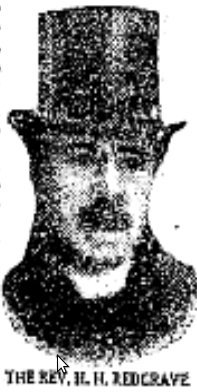 VICAR AND WORKING GIRL
CHARGES AFTER PROMISE TO A DYING MOTHER VICAR AND WORKING GIRL
CHARGES AFTER PROMISE TO A DYING MOTHER
After the mother's death the girl went to the vicarage as a servant.The
defendant had been consistently with her and had conducted himself with
her in the presence of witnesses in a manner which could lead only to
one conclusion. When the vicar sometimes had meals with her he had been
seen to squeeze her hand and press her foot. Upon one occasion when a
girl friend of Miss Gater entered the dining-room, she found the vicar
in an arm-chair with Miss Gater on his knee. On July 19 last year the
vicar was in an hotel in the Strand, London, with Miss Gater and a
woman named Mumford, whom he had engaged to look after her. Mumford
went to the girl's room and found the door locked. It was opened by the
vicar and she found Miss Gater alone with him. The defendant had bought
clothes for the girl and directed tradesmen to send them to a
neighbour's address. He had rented houses at Stafford and Leicester
where he had stayed with her. At the latter place a house was taken in
the name of Lucas, and by that name the defendant was known to the
tradesmen.
Alice May Pindler, thirteen, grand-daughter of a sidesman, said that
when she went with the vicar and Miss Gater to Rudyard Lake they
travelled in a first-class carriage and the vicar put his arm round
Miss Gater's waist. He bought some chocolates for them and a spray of
roses for Miss Gater. At Rudyard Lake a storm was threatening and got
up from the seat, the vicar having hold of Miss Gater's arm. The storm
becoming more threatening, the vicar said he would offer up a little
prayer that the thunder and lightning might hold off. She once heard
the vicar say that Miss Gater was a naughty girl because she had not
given him a kiss that day.
NOT IN SERVANT'S DRESS
Herbert Jennings, headmaster of St. Paul's School, said he frequently
visited the vicarage. When the girl first went there she was treated as
a servant, wearing a cap and apron. After some time she put aside
servant's clothes. The girl was not popular with the family.
Lily Brett, a companion of Miss Gater, said the vicar always made a
terrible fuss of Miss Gater. He would put his arm round her, drink tea
out of her cup, and kiss her. Once or twice he had come into Miss
Gater's bedroom when the witness was there. On one occasion she went
with Miss Gater to Newcastle-under-Lyme. They met the vicar, who took
them to a tea shop and bought strawberries and cherries. He bought Miss
Gater gloves and took them to a picture theatre.
Questioned by Mr. Vachell for the defendant, she admitted that Miss
Gater told her she had been adopted by the Redgraves. She also heard
that this had caused annoyance to the sons and daughters at home. The
hearing was adjourned until today.
|
The court stated that it regarded the possibility of adultery having
occurred with the gravest suspicion, although it was not prepared to
find the charge proved, believing the relationship was one of passion
and affection. (In due course Hannah bore him seven children, in
addition to the four from his first marriage.) As a consequence,
Redgrave held no ecclesiastical office until he came to St John's nine
years later - though was a tutor for a year at King's London, his old
college, in 1921. In 1934 his permission to officiate was transferred
to Somers Town, and the following year to St Jude Bethnal Green; and in
1937 he was appointed Vicar of Stow Bedon with Breccles, in Norfolk,
from which he retired to Hastings in 1949. The family has produced several generations of actors; Hyma's brother was the grandfather of Sir Michael Regrave.
For a short time in 1935 Clifford John Nash
was a curate here (see below for the Vicar's comments). He was a graduate of the evangelical Ridley College,
Melbourne in Australia (from which he received a higher degree in absentia in
1944 - in 1945 he was selected for the Grainger postgraduate scholarship
to study for the degree of Bachelor of Divinity at Sydney University),
and had served three curacies there (successfully starting a scout troop
in one parish). He came here under the terms of the 1874 Colonial
Clergy Act, and lived at Pierhead House, Wapping. He returned to Australia
as vicar of Christ Church Melton in 1937, and two years
later published As
in the Days of Noah: A Christian's Guide through World Chaos
(Marshall Morgan & Scott); he was a part-time lecturer in Semitic
Studies at Sydney University. He died in 1948; his funeral was at
Sydney Cathedral.
Dudley James Milne Gray was a Durham graduate who trained
at St
Augustine's College Canterbury (where he was secretary of the college
cricket team - of which several years later Alex Solomon was a member),
and began his ministry in Tottenham in 1931 before serving at Tai-an
and then Pingyin in China with SPG; he came to a curacy at St John's a sick man in 1935 (his wife was an honorary 'lady worker', along
with Miss R. Clifton) and expressed gratitude for the value of his time here, and the Vicar praised his loyalty, dilgence and untiring visitation and thoroughness ... he particularly attracted the children. He left in 1937 to build up a new congregation at
St Luke Leagrave in
Luton - parochial conditions are different at Luton, human nature is the same, wrote the Vicar. Under the heading 'Two Departures and No Arrival' he asked who will fill the gap? Pray that we may be guided aright, for the East End requires only the very best man possible. By contrast, on the departure of Clifford Nash for 'the land of his
adoption', he merely noted [mis-naming him as 'C.V. Nash'] Many felt that Mr. Nash was better
suited to Australian life, 'up country' ... he visited us before he
embarked and we joined together in prayer.
St Luke Leagrave began as a conventional district of Biscot, to serve a
rapidly-growing area of Luton; worship was in a 'tin tabernacle' until
a dual-purpose church was built, but this burnt down in 1947; a new church was built in 1956. The present incumbent is Grace Sentamu-Baverstock, daughter of the Archbishop of York.
The Parish newsletter lists W.R. Perry as an honorary assistant at this period [details needed], and from 1937 Frank Anderson Moss Ellis
as curate: he officiated at baptisms and weddings, but left when it turned out that he had not in fact been
canonically ordained!
FINAL
DAYS
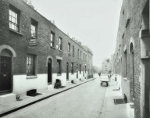 Hubert Alfred Robins became
priest-in-charge in 1940 (appointed by the Crown because the see of
London was vacant at the time), for what must have
been a sad incumbency. Born in 1895, he had trained at St Boniface
College Warminster
(King's College) and was ordained in 1936, served two two-year local
curacies, at Holy Trinity, Mile End Old Town, and Christ Church
Stepney. He left in
1943 when local clergy were centred on St George-in-the-East, to become
vicar of St Erkenwald, Southend, and then in 1952 to two parishes in
Devon, Shebbear and Buckland Filleigh
(with two years as rural dean of Torrington) before retiring to
Cornwall in 1968, living in Lesnewth, Bocastle. (Right is Golding Street in 1937.)
Hubert Alfred Robins became
priest-in-charge in 1940 (appointed by the Crown because the see of
London was vacant at the time), for what must have
been a sad incumbency. Born in 1895, he had trained at St Boniface
College Warminster
(King's College) and was ordained in 1936, served two two-year local
curacies, at Holy Trinity, Mile End Old Town, and Christ Church
Stepney. He left in
1943 when local clergy were centred on St George-in-the-East, to become
vicar of St Erkenwald, Southend, and then in 1952 to two parishes in
Devon, Shebbear and Buckland Filleigh
(with two years as rural dean of Torrington) before retiring to
Cornwall in 1968, living in Lesnewth, Bocastle. (Right is Golding Street in 1937.)
 When
the church closed in 1943 it
was used
as a store for furnishings from bomb-damaged churches (the
eventual disposal of these items, at the expense of the East End, makes
an interesting, and rather shocking, story). By
1960 the building was in a terrible state; vandals had broken in and
smashed all the furniture and wrecked most of the windows; even the
stone pulpit was broken. The floor was littered with old hymnbooks
and bibles, parish magazines and marble wall-monuments from St Peter
Regent Square. Locals had dumped mouldering settees and chairs. The
diocesan authorities had attempted to prevent entry by overturning
the stone font against the main door, but to no avail. The building
was demolished in 1964.
When
the church closed in 1943 it
was used
as a store for furnishings from bomb-damaged churches (the
eventual disposal of these items, at the expense of the East End, makes
an interesting, and rather shocking, story). By
1960 the building was in a terrible state; vandals had broken in and
smashed all the furniture and wrecked most of the windows; even the
stone pulpit was broken. The floor was littered with old hymnbooks
and bibles, parish magazines and marble wall-monuments from St Peter
Regent Square. Locals had dumped mouldering settees and chairs. The
diocesan authorities had attempted to prevent entry by overturning
the stone font against the main door, but to no avail. The building
was demolished in 1964.
St John's House, the Parish Institute at 20 Christian Street (next to what had
been a synagogue until the 1920s - the site was rebuilt, and is now a
mosque) remained for a time. Nora Neal lived here, and ran various clubs on the premises. The local Franciscans used space as an extra classroom for English language classes for immigrants.
No
Trees in the Street
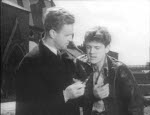
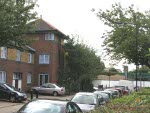
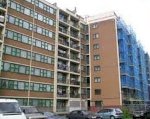
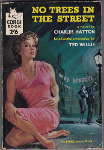 A
1959 film, rated as sincere but
saccharine, featuring
Ronald Howard, Stanley Holloway, David Hemmings, Sylvia Sims, Melvyn
Hayes and Herbert Lom: a retired policeman who shows a young
criminal how a similar lad went astray twenty years previously.
A
1959 film, rated as sincere but
saccharine, featuring
Ronald Howard, Stanley Holloway, David Hemmings, Sylvia Sims, Melvyn
Hayes and Herbert Lom: a retired policeman who shows a young
criminal how a similar lad went astray twenty years previously.
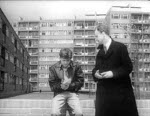
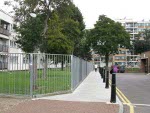 Some shots were filmed locally - left are stills of
Hemmings
and
Howard outside the church entrance in Golding Street, and round
the corner outside Delafield House and Drewett House in Burslem Street,
next to contemporary pictures (now with trees!) of these spots. Right is Delafield House today.
Some shots were filmed locally - left are stills of
Hemmings
and
Howard outside the church entrance in Golding Street, and round
the corner outside Delafield House and Drewett House in Burslem Street,
next to contemporary pictures (now with trees!) of these spots. Right is Delafield House today.
SpacE1

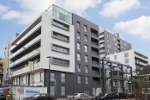
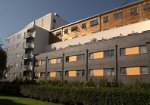
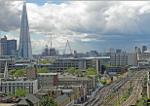 In
2003 London Borough of Tower Hamlets agreed to the sale of the former school between Christian and Golding
Streets (see here
for its history, as a Board School and later as Bishop Challoner Girls'
Secondary School), and adjacent playing field, for a housing
development by
Bellway Homes, who proposed 277 units (35% of them affordable housing),
with leisure and community facilities. This proved too much for the
site, so plans were scaled down and finally agreed in 2007, with 150
units, of which 61 are 'affordable' housing. Right is a view from the new flats looking towards the Shard.
In
2003 London Borough of Tower Hamlets agreed to the sale of the former school between Christian and Golding
Streets (see here
for its history, as a Board School and later as Bishop Challoner Girls'
Secondary School), and adjacent playing field, for a housing
development by
Bellway Homes, who proposed 277 units (35% of them affordable housing),
with leisure and community facilities. This proved too much for the
site, so plans were scaled down and finally agreed in 2007, with 150
units, of which 61 are 'affordable' housing. Right is a view from the new flats looking towards the Shard.
Homepage | About Us | Services & Events
| Church &
Churchyard |
History
Newsletters & Sermons | Contacts,
Links & Registers | Giving | Picture
Gallery |
Site Map


 The
architects were the Francis brothers Frederick John (1818-96) and
Horace (1821-94), whose practice was at 38 Upper Bedford Place,
Bloomsbury; Messrs Dove were the builders. The foundation
stone
was laid by the
Bishop of London on 29 April 1868, and he consecrated the church on
12 February 1869, with the Archbishop of Canterbury present [drawing left from the Illustrated London News, 20 February 1869; ICBS plan 06719 of new church, with gallery, right]. Mr
Vaughan was inducted as the first vicar.
The
architects were the Francis brothers Frederick John (1818-96) and
Horace (1821-94), whose practice was at 38 Upper Bedford Place,
Bloomsbury; Messrs Dove were the builders. The foundation
stone
was laid by the
Bishop of London on 29 April 1868, and he consecrated the church on
12 February 1869, with the Archbishop of Canterbury present [drawing left from the Illustrated London News, 20 February 1869; ICBS plan 06719 of new church, with gallery, right]. Mr
Vaughan was inducted as the first vicar.




 The 1878 Vestry map [left]
shows the area served by the church: at that time, a mix of very poor
dwellings and industrial sites, many of whose owners are identified on the map. Left is
also Grove Street (looking north) in the late 19th century, and Goad's
insurance map of 1899 showing the block around the church, which was
surrounded by tenements to the north (Bewley and Ficklin Buildings) and
small houses with workshops behind to the east and south, with a pub
next door but one (the Jolly Sailor, 85 Grove Street - which had a
German landlady in the 1890s). Only the south side of the church was
visible. It became
an increasingly Jewish area, as settlers moved east from Whitechapel - right is a 1913 tailors' workshop in Christian Street, and a shop in Ellen Street in the 1930s. More pictures here.
The 1878 Vestry map [left]
shows the area served by the church: at that time, a mix of very poor
dwellings and industrial sites, many of whose owners are identified on the map. Left is
also Grove Street (looking north) in the late 19th century, and Goad's
insurance map of 1899 showing the block around the church, which was
surrounded by tenements to the north (Bewley and Ficklin Buildings) and
small houses with workshops behind to the east and south, with a pub
next door but one (the Jolly Sailor, 85 Grove Street - which had a
German landlady in the 1890s). Only the south side of the church was
visible. It became
an increasingly Jewish area, as settlers moved east from Whitechapel - right is a 1913 tailors' workshop in Christian Street, and a shop in Ellen Street in the 1930s. More pictures here. David Nickerson (1875-76)
was Canadian, studied at King's College Windsor in Nova Scotia and was
ordained in 1868, serving in three parishes in Nova Scotia
and New Brunswick, the last including a chaplaincy to the British Army.
After his short time here, and a year as chaplain to the Islington
Union, he became a Chaplain to
the Forces, with postings in this country and abroad (including Cyprus,
Egypt and Malta) for the next two decades. While in Portmouth in 1887
he published a threepenny broadsheet under the odd pseudonymn 'Don't
Care' Is Free Trade a Mistake? [echoing an earlier title of John Bright, and an ongoing debate], Dedicated to the Production of England, both Capital & Labour. He said at a
conference that the best prospect for a Poor Law child was to draft him
into the army or navy. He became
curate of Netley in 1900, Rector of North Stoke (near Bath) in 1902 and
Vicar of Harlington, near Dunstable, in 1905. Before he left the
Army, he produced The Origin of Thought (Kegan,
Paul
& Trench 1901), an introduction to philosophy 'for thoughtful
people of good education but who have not read philosophy', in a light and popular manner, said one
review, but with a misleadingly
abstruse title. Another review, Black and White, said while
on some points the book is philosophically unsound, it is written in
such a bright, attractive way that no one can read it without being
charmed by the personality of the writer. He described in detail a baby's growth to consiciousness, and speculated on the links between thought and electricity. In
1909 he became vicar of Newton-upon-Ouse in Yorkshire (Elsie Folkes,
his servant in Harlington, successfully suing him on his departure for
£2 in lieu of notice). His son Major General William
Henry Snyder Nickerson was a Canadian recipient of the Victoria
Cross for his service, as a lieutenant in the Royal Arrmy Medical
Corps, to a wounded man at Wakkerstroom in the Boer War.
David Nickerson (1875-76)
was Canadian, studied at King's College Windsor in Nova Scotia and was
ordained in 1868, serving in three parishes in Nova Scotia
and New Brunswick, the last including a chaplaincy to the British Army.
After his short time here, and a year as chaplain to the Islington
Union, he became a Chaplain to
the Forces, with postings in this country and abroad (including Cyprus,
Egypt and Malta) for the next two decades. While in Portmouth in 1887
he published a threepenny broadsheet under the odd pseudonymn 'Don't
Care' Is Free Trade a Mistake? [echoing an earlier title of John Bright, and an ongoing debate], Dedicated to the Production of England, both Capital & Labour. He said at a
conference that the best prospect for a Poor Law child was to draft him
into the army or navy. He became
curate of Netley in 1900, Rector of North Stoke (near Bath) in 1902 and
Vicar of Harlington, near Dunstable, in 1905. Before he left the
Army, he produced The Origin of Thought (Kegan,
Paul
& Trench 1901), an introduction to philosophy 'for thoughtful
people of good education but who have not read philosophy', in a light and popular manner, said one
review, but with a misleadingly
abstruse title. Another review, Black and White, said while
on some points the book is philosophically unsound, it is written in
such a bright, attractive way that no one can read it without being
charmed by the personality of the writer. He described in detail a baby's growth to consiciousness, and speculated on the links between thought and electricity. In
1909 he became vicar of Newton-upon-Ouse in Yorkshire (Elsie Folkes,
his servant in Harlington, successfully suing him on his departure for
£2 in lieu of notice). His son Major General William
Henry Snyder Nickerson was a Canadian recipient of the Victoria
Cross for his service, as a lieutenant in the Royal Arrmy Medical
Corps, to a wounded man at Wakkerstroom in the Boer War. Joseph Vaughan, the first incumbent, initially lived at 33 Nassau Place, Commercial
Road East, and later at 12 Commercial Place, but all his successors lived at 400
Commercial Road [left], a
4-storey terrace house at some remove from the parish and in a noisy location. At 384-392 was the SPCK training college (see here) and at 394-396 a maternity hospital
(founded as the Mothers' Lying-in Home in Glamis Road, moving to this
site as the East End Mothers' Home, 1902-03, and becoming the East End Mothers' Lying-in Home
1903-26, taking over the college premises; more details here.
Joseph Vaughan, the first incumbent, initially lived at 33 Nassau Place, Commercial
Road East, and later at 12 Commercial Place, but all his successors lived at 400
Commercial Road [left], a
4-storey terrace house at some remove from the parish and in a noisy location. At 384-392 was the SPCK training college (see here) and at 394-396 a maternity hospital
(founded as the Mothers' Lying-in Home in Glamis Road, moving to this
site as the East End Mothers' Home, 1902-03, and becoming the East End Mothers' Lying-in Home
1903-26, taking over the college premises; more details here. 
 The penultimate
vicar
(1919-39) was Henry
Shrubbs.
Born in Cambridge in 1880, he was a schoolmaster when he married
Maud Allen in Lambeth in 1903; he then studied at Fitzwilliam Hall [not
yet a college] in Cambridge and
trained at Ridley Hall, and was ordained in 1908 to curacies at St
Thomas Stepney (when he lived at 432 Commercial Road, close to St
John's vicarage) and Christ Church Spitalfields. He he
was involved with the Church Army, and to the disapproval of some
conducted
a number of baptisms at
their local headquarters. The parish magazine - buses 15a,
23a and
40a, trams from Aldgate and Bloomsbury [see here for more details] - set out his pitch » » »
The penultimate
vicar
(1919-39) was Henry
Shrubbs.
Born in Cambridge in 1880, he was a schoolmaster when he married
Maud Allen in Lambeth in 1903; he then studied at Fitzwilliam Hall [not
yet a college] in Cambridge and
trained at Ridley Hall, and was ordained in 1908 to curacies at St
Thomas Stepney (when he lived at 432 Commercial Road, close to St
John's vicarage) and Christ Church Spitalfields. He he
was involved with the Church Army, and to the disapproval of some
conducted
a number of baptisms at
their local headquarters. The parish magazine - buses 15a,
23a and
40a, trams from Aldgate and Bloomsbury [see here for more details] - set out his pitch » » »

 Despite
a low church stance, he maintained two (sometimes three)
celebrations of the eucharist each Sunday - though it seems from the
details here, from The Parish Record
of 1937 (no.210), that 11am was a 'stay-behind' following Mattins -
plus on saints' days, and a midweek service of Compline. The list of
staff and organisations is interesting: there was a full
programme (and the registers show reasonable numbers), yet when the war came, although the church was not blitzed, it failed quite rapidly. Right is a picture of a 'Bucket Parade in Camp' (?) from 1937, and left the church interior in the 1930s. Several
other items in this edition of the magazine are also of interest, both
for the attitudes they reveal and for the contrast with today, for instance on safeguarding, multiculturalism and bank interest rates!
Despite
a low church stance, he maintained two (sometimes three)
celebrations of the eucharist each Sunday - though it seems from the
details here, from The Parish Record
of 1937 (no.210), that 11am was a 'stay-behind' following Mattins -
plus on saints' days, and a midweek service of Compline. The list of
staff and organisations is interesting: there was a full
programme (and the registers show reasonable numbers), yet when the war came, although the church was not blitzed, it failed quite rapidly. Right is a picture of a 'Bucket Parade in Camp' (?) from 1937, and left the church interior in the 1930s. Several
other items in this edition of the magazine are also of interest, both
for the attitudes they reveal and for the contrast with today, for instance on safeguarding, multiculturalism and bank interest rates! VICAR AND WORKING GIRL
VICAR AND WORKING GIRL Hubert Alfred Robins became
priest-in-charge in 1940 (appointed by the Crown because the see of
London was vacant at the time), for what must have
been a sad incumbency. Born in 1895, he had trained at St Boniface
College Warminster
(King's College) and was ordained in 1936, served two two-year local
curacies, at Holy Trinity, Mile End Old Town, and Christ Church
Stepney. He left in
1943 when local clergy were centred on St George-in-the-East, to become
vicar of St Erkenwald, Southend, and then in 1952 to two parishes in
Devon, Shebbear and Buckland Filleigh
(with two years as rural dean of Torrington) before retiring to
Cornwall in 1968, living in Lesnewth, Bocastle. (Right is Golding Street in 1937.)
Hubert Alfred Robins became
priest-in-charge in 1940 (appointed by the Crown because the see of
London was vacant at the time), for what must have
been a sad incumbency. Born in 1895, he had trained at St Boniface
College Warminster
(King's College) and was ordained in 1936, served two two-year local
curacies, at Holy Trinity, Mile End Old Town, and Christ Church
Stepney. He left in
1943 when local clergy were centred on St George-in-the-East, to become
vicar of St Erkenwald, Southend, and then in 1952 to two parishes in
Devon, Shebbear and Buckland Filleigh
(with two years as rural dean of Torrington) before retiring to
Cornwall in 1968, living in Lesnewth, Bocastle. (Right is Golding Street in 1937.)
 When
the church closed in 1943 it
was used
as a store for furnishings from bomb-damaged churches (the
eventual disposal of these items, at the expense of the East End, makes
an interesting, and rather shocking, story). By
1960 the building was in a terrible state; vandals had broken in and
smashed all the furniture and wrecked most of the windows; even the
stone pulpit was broken. The floor was littered with old hymnbooks
and bibles, parish magazines and marble wall-monuments from St Peter
Regent Square. Locals had dumped mouldering settees and chairs. The
diocesan authorities had attempted to prevent entry by overturning
the stone font against the main door, but to no avail. The building
was demolished in 1964.
When
the church closed in 1943 it
was used
as a store for furnishings from bomb-damaged churches (the
eventual disposal of these items, at the expense of the East End, makes
an interesting, and rather shocking, story). By
1960 the building was in a terrible state; vandals had broken in and
smashed all the furniture and wrecked most of the windows; even the
stone pulpit was broken. The floor was littered with old hymnbooks
and bibles, parish magazines and marble wall-monuments from St Peter
Regent Square. Locals had dumped mouldering settees and chairs. The
diocesan authorities had attempted to prevent entry by overturning
the stone font against the main door, but to no avail. The building
was demolished in 1964.


 A
1959 film, rated as sincere but
saccharine, featuring
Ronald Howard, Stanley Holloway, David Hemmings, Sylvia Sims, Melvyn
Hayes and Herbert Lom: a retired policeman who shows a young
criminal how a similar lad went astray twenty years previously.
A
1959 film, rated as sincere but
saccharine, featuring
Ronald Howard, Stanley Holloway, David Hemmings, Sylvia Sims, Melvyn
Hayes and Herbert Lom: a retired policeman who shows a young
criminal how a similar lad went astray twenty years previously.
 Some shots were filmed locally - left are stills of
Hemmings
and
Howard outside the church entrance in Golding Street, and round
the corner outside Delafield House and Drewett House in Burslem Street,
next to contemporary pictures (now with trees!) of these spots. Right is Delafield House today.
Some shots were filmed locally - left are stills of
Hemmings
and
Howard outside the church entrance in Golding Street, and round
the corner outside Delafield House and Drewett House in Burslem Street,
next to contemporary pictures (now with trees!) of these spots. Right is Delafield House today.


 In
2003 London Borough of Tower Hamlets agreed to the sale of the former school between Christian and Golding
Streets (see here
for its history, as a Board School and later as Bishop Challoner Girls'
Secondary School), and adjacent playing field, for a housing
development by
Bellway Homes, who proposed 277 units (35% of them affordable housing),
with leisure and community facilities. This proved too much for the
site, so plans were scaled down and finally agreed in 2007, with 150
units, of which 61 are 'affordable' housing. Right is a view from the new flats looking towards the Shard.
In
2003 London Borough of Tower Hamlets agreed to the sale of the former school between Christian and Golding
Streets (see here
for its history, as a Board School and later as Bishop Challoner Girls'
Secondary School), and adjacent playing field, for a housing
development by
Bellway Homes, who proposed 277 units (35% of them affordable housing),
with leisure and community facilities. This proved too much for the
site, so plans were scaled down and finally agreed in 2007, with 150
units, of which 61 are 'affordable' housing. Right is a view from the new flats looking towards the Shard.